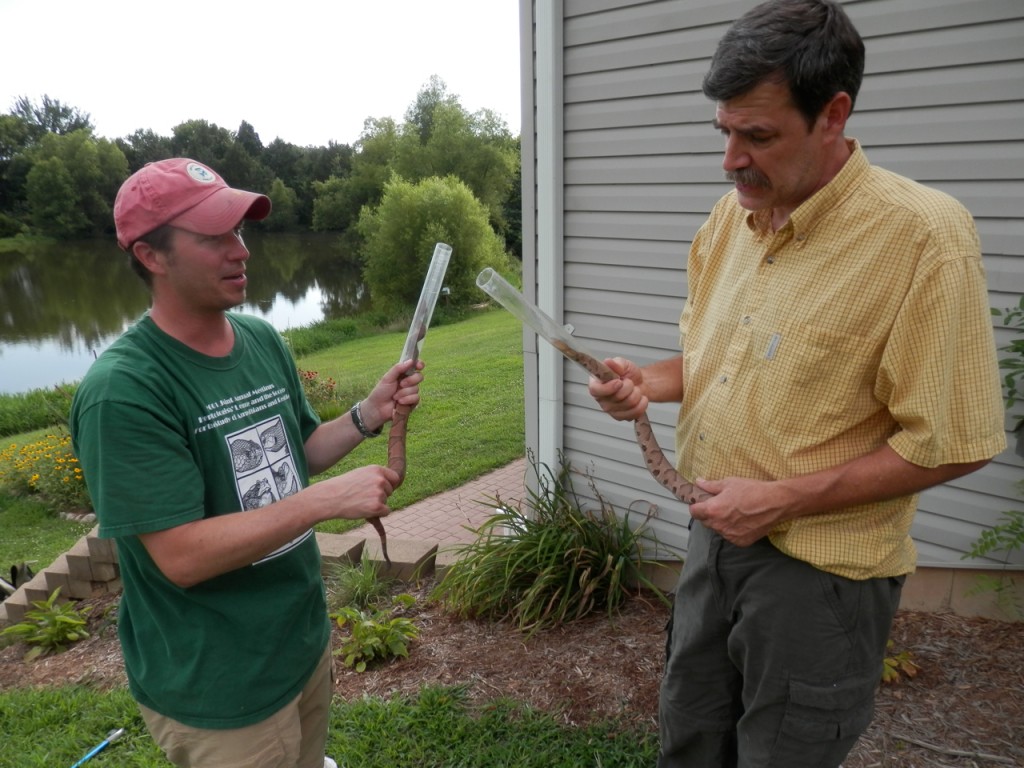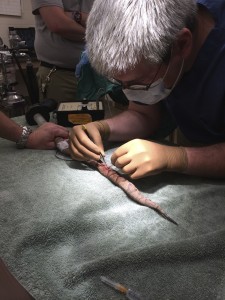Copperhead Snakes: Part of the Neighborhood

Ben Jellen, left, and Bob Weck, safely hold captured copperhead snakes in plastic tubes. The snakes were sexed, weighed, and assessed for health prior to having radio tracking tags implanted. Photo courtesy Jim Hill, Clifftop.
There is no such things as snakes. Believe it or not, this is a true statement. Just ask any herpetologist (a person who studies reptiles and amphibians). What we call “snakes” are really just a specialized group of lizards. This probably doesn’t help anyone sleep at night though – sort of the flip side of the coin for “a rose by any other name would smell as sweet”. Since the biblical serpent in the Garden of Eden, the history of snakes has long been entwined with humans and they have been depicted as evil or treacherous, killed upon sight and had their habitats destroyed.
For most people, the very sight of a snake causes fear or uneasiness. In Illinois there are only four venomous snake species out of approximately 40 native snake species in total. They are the copperhead, timber rattlesnake, massaugua rattlesnake and cottonmouth. Besides these snake species, other much more common venomous animals species living in Illinois are spiders, bees & wasps and scorpions. Certain wild plants, berries and mushrooms that can make you ill or worse if ingested are called poisonous. Statistically, lightening kills many more people yearly than venomous snakes do and you have an even much greater chance of dying in an automobile accident than being bitten by a venomous snake. Yet, people don’t seem to be afraid of cars.
Snakes are one of the most misunderstood creatures alive today. For example, the harmless milk snake, a common snake in southern Illinois and unfortunately a popular species in the pet trade because of its vibrant colors and docile nature, originally got its name because it was frequently encountered in barns. Thus, farmers assumed it was there to drink milk from the dairy cows or goats. Well, the fact is humans are the only animal that continues to drink milk after infancy, and the milk snake and other snake species are present to eliminate rodents which are in the barn eating stored grains. The general misunderstanding of snakes seems to be at the root of this animosity.
One of the more common venomous snakes in Illinois is the Copperhead. Though a healthy respect for any venomous snake is warranted, fear of this animal is not. Unless someone is allergic to Copperhead venom in the same way someone can be allergic to venom from bee stings, a bite is rarely, if ever, fatal.
The vast majority of venomous snake bites occur to a person’s hands or fingers – meaning that person was way too close and likely doing something they shouldn’t with the snake. A high percentage of venomous snake bites are caused by reckless human behavior that are often alcohol related. Usually the snake typically gets the blame for being aggressive, when it is merely defending itself.

A St. Louis Zoo veterinarian surgically implants a transmitting device into a Copperhead Snake for research on their habitat use.
Over the past two years, biologists Dr Benjamin C. Jellen, Robert G. Weck and collge students have been researching Copperheads in St. Clair and Monroe Counties. To study snakes, especially a species such as the Copperhead, who is a master of camouflage, generally requires a certain degree of “luck” to find one, and even “luckier” to find the exact same individual repeatedly over the course of the year or years. That issue is resolved with the use of radio telemetry technology and where the St. Louis Zoo comes in to help in a big way. The veterinarians at the Animal Hospital volunteer their time to put the snakes captured for the study through a procedure in which a small radio transmitter is implanted in a body cavity. The snake is then released back into the location and habitat where it was found This transmitter has a set frequency which can be detected by a receiver to follow this signal and lead Dr Jellen and his fellow researchers directly to the individual with the transmitter inside it. This technology provides the ability to find a particular individual as often as needed to find out where its moving, what kind of habitat it is in, its behavior, and to periodically check its overall health, growth, and hormone levels. DNA is taken from every individual studied to examine population genetics and individually mark all individuals with the same type of microchip your dog or cat might have in case it is ever lost.
What has been learned so far from this research project? Generally males move considerably farther than females and that adults have (so far) have tended to hibernate individually in rodent burrows on slopes (particularly around wooded sinkholes). We have also learned that females give birth relatively close to where the babies and she will hibernate that year, that birthing occurs about every two years, and in areas with abundant rodent burrows. This likely gives the babies (a.k.a. neonates) shelter and a potential first meal. Also, documenting snake mortality in the wild has revealed that Copperheads fall prey to a large number of animals including cats, dogs, raptors, turkeys, other snakes, coyotes, and moles. Yes moles. Their biggest threat is through blatant persecution and intentional killing by humans as a result of misunderstanding, and habitat loss.
Despite what most people think, Copperheads are not aggressive. Their main defense is to rely on camouflage. They blend in very well with fallen leaves, brush and grass. If provoked, they will defend themselves after first trying to retreat. Put yourself in their shoes, what would you do if a giant came after you with a shovel or picked you up in their hands? One thing that most people do not know is that venomous snakes can choose whether or not to inject venom. And if they do, how much venom to inject. While much has been learned about Copperheads, there is still much that remains unknown.
Snakes have a long history with humans. Humans can be responsible stewards of the environment we share with all life – not just the cute and cuddly creatures. Come and learn about what you can do to help keep our natural areas wild and specifically appreciate snakes. Remember, as world renowned ecologist Aldo Leopold once said, “To keep every cog and wheel is the first precaution of intelligent tinkering.”
CLIFFTOP, a local nonprofit organization, is focused on preserving and protecting area bluff lands. A version of this article appeared in the 3 June 2016 edition of the Monroe County Independent.
© 2016 all content rights reserved Clifftop NFP
Comments are currently closed.
